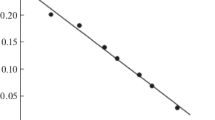Abstract
The uptake of purified diphtheria toxin by two different kinds of human cells culturedin vitro (human adult hepatocytes and HEp-2 cell cultures) was studied by observations in fluorescence microscopy.
Both these cell cultures rapidly take up diphtheria toxin by pinocytosis, a process fully similar to that involved in the uptake of this same toxin by leukocytes or other cells destined to organism defense.
Pinocytosis of diphtheria toxin is not inhibited by specific antiserum and, moreover, anatoxin is accepted by these cells in the same way as diphtheria toxin. Diphtheria toxin is, then, accepted by cells as a foreign protein and not for its toxic properties.
Similar content being viewed by others
References
Amante, L., Giuriani, M.: La coniugazione con isotiocianato di fluoresceina di due picchi cromatografici di gamma-globuline basiche da antisiero di pecora. Boll. Ist. sieroter, milan.48, 407–411 (1969)
Chapman-Andresen, C., Holtzer, H.: The uptake of fluorescent albumin by pinocytosis inAmoeba proteus. J. biophys. biochem. Cytol.8, 288–291 (1960)
Collier, R. J., Pappenheimer, A. M., Jr.: Studies on the mode of action of diphtheria toxin. I. Phosphorylated intermediate, in normal and intoxicated HeLa cells. J. exp. Med.120, 1007–1018 (1964)
Holter, H., Holtzer, H.: Pinocytotic uptake of fluorescein-labeled proteins by various tissue cells. Exp. Cell Res.18, 421–423 (1959)
Hug, G., Schubert, W. K.: Lysosomes in type II-glycogenosis. Changes during administration of extract fromAspergillus niger. J. Cell Biol.35, C1-C6 (1967)
Jacques, P. J.: épuration plasmatique de protéines étrangers, leur capture et leur destinée dans l'appareil vacuolaire du foie. Louvain, Belgium: Libraire Universitaire Uyst pruyst 1968
Kato, I., Sato, H.: Mode of action of diphtheria toxin on protein synthesis. Jap. J. exp. Med.32, 495–504 (1962)
Koshland, M. E.: Mechanism of antibody formation. I. Fate of I131-labeled diphtheria toxoid at the site of antibody formation. J. Immunol.79, 162–171 (1957)
Lennox, E. S., Kaplan, A.: Action of diphtheria toxin on cells cultivatedin vitro. Proc. Soc. exp. Biol. (N. Y.)95, 700–702 (1957)
Mesrobeanu, I., Bona, C., Ioanid, L., Mesrobeanu, L.: Pinocytosis of some exotoxins by leukocytes. Exp. Cell Res.42, 490–499 (1966)
Mesrobeanu, I., Bona, C., Mesrobeanu, L.: Pinocvtosis by leukocytes of “O” endotoxins. Exp. Cell Res.36, 434–438 (1964)
Mesrobeanu, I., Mesrobeanu, L., Bona, C.: Pinocytose des toxines par les leucocytes provenant d'animaux normaux et immunisés. Méd. et Hyg. (Genève)25, 197–198 (1967)
Morell, A. G., Irvine, R. A., Sternlieb, I., Scheinberg, I. H.: Physical and chemical studies on ceruloplasmin. V. Metabolic studies on sialic acid-free ceruloplasminin vivo. J. biol. Chem.243, 155–159 (1968)
Paradisi, F.: Mitochondrial changes induced by diphtheria toxin in chicken embryo heart cell cultures. Experientia (Basel)22, 373–375 (1966)
Paradisi, F.: Mitochondrial swelling induced by diphtheria toxin in cell cultures. Path. et Microbiol. (Basel)30, 481–494 (1967)
Paradisi, F., Trapani, A., Graziano, L.: The effect of diphtheria toxin on primary cell cultures of the human adult liver. Experientia (Basel) in the press (1974)
Placido-Sousa, C., Evans, D. G.: The action of diphtheria toxin on tissue cultures and its neutralization by antitoxin. Brit. J. exp. Path.38, 644–649 (1957)
Ploem, J. S.: The use of vertical illuminator with interchangeable dicroic mirrors for fluorescence microscopy with incident light. Z. wiss. Mikr.68, 129–142 (1967)
Strauss, N.: The effect of diphtheria toxin on the metabolism of HeLa cells. II. Effect on nucleic acids metabolism. J. exp. Med.112, 341–359 (1960)
Strauss, N., Hendee, E. D.: The effect of diphtheria toxin on the metabolism of HeLa cells. J. exp. Med.109, 145–163 (1959)
Stavitsky, A.:In vitro studies on the antibody response. Advanc. in Immunol.1, 211–261 (1961)
Wood, B. T., Thomson, S. H., Goldstein, G.: Fluorescent antibody staining. III. Preparation of fluorescein isothiocyanate-labeled antibodies. J. Immunol.95, 225–229 (1965)
Zuckerman, A. J., Tsiquaye, K. N., Fulton, F.: Tissue culture of human embryo liver cells and the cytotoxicity of aflatoxin B1. Brit. J. exp. Path.48, 20–27 (1967)
Author information
Authors and Affiliations
Rights and permissions
About this article
Cite this article
Paradisi, F. Pinocytosis of diphtheria toxin by different types of human cells culturedin vitro . Med Microbiol Immunol 160, 257–263 (1974). https://doi.org/10.1007/BF02121440
Received:
Issue Date:
DOI: https://doi.org/10.1007/BF02121440




